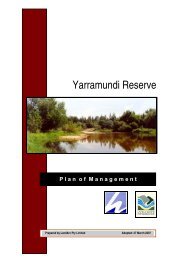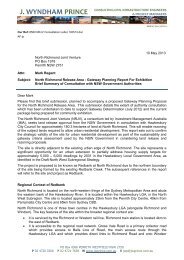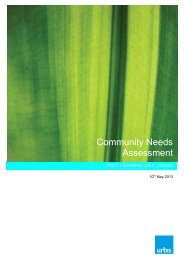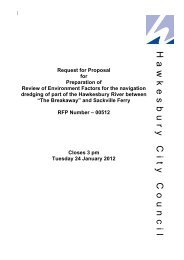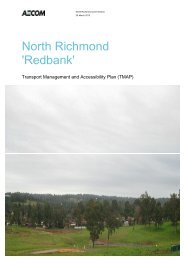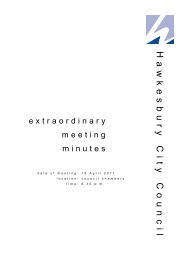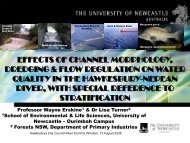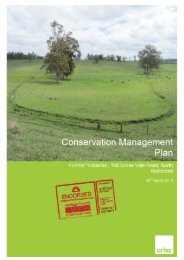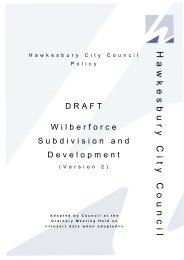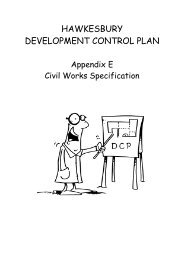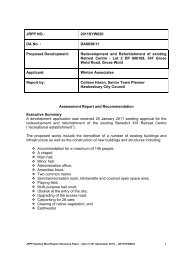Attachment 1 to Item 53 - Roadside Vegetation Management Plan
Attachment 1 to Item 53 - Roadside Vegetation Management Plan
Attachment 1 to Item 53 - Roadside Vegetation Management Plan
You also want an ePaper? Increase the reach of your titles
YUMPU automatically turns print PDFs into web optimized ePapers that Google loves.
H AW K E S B U R Y C IT Y C O U N C IL R O AD S ID E V E G E T AT IO N M AN AG E M E N T P L AN<br />
• Designate a set number of s<strong>to</strong>ckpile or dump sites at strategic locations (selected and<br />
approved by the relevant Council officer) for:<br />
o s<strong>to</strong>ring road work materials (e.g. Road metal, <strong>to</strong>psoil, gravel, mulch);<br />
o s<strong>to</strong>ring excess material from road construction or maintenance operations;<br />
o disposal of pest plants and other materials.<br />
• Avoid using the following as s<strong>to</strong>ckpile or dump sites;<br />
o areas adjacent <strong>to</strong> high conservation priority roads, National Parks and public<br />
reserves;<br />
o way side s<strong>to</strong>p sites; and<br />
o drainage lines, floodways or culverts.<br />
• When selecting new s<strong>to</strong>ckpile or dump sites consider locating them:<br />
o on roadsides or public land of low conservation value;<br />
o in areas which have previously been cleared of vegetation; and<br />
o in areas which can be screened from view.<br />
• Provide all statu<strong>to</strong>ry authorities and contrac<strong>to</strong>rs undertaking road works with a list and<br />
location map of designated s<strong>to</strong>ckpile and dump sites;<br />
• Define the extent of s<strong>to</strong>ckpile or dump sites. Use the minimum space necessary <strong>to</strong><br />
s<strong>to</strong>re/dump materials and maintain access. Establish a buffer zone around s<strong>to</strong>ckpiles or<br />
dump sites if possible;<br />
• Mark the boundaries of s<strong>to</strong>ckpile sites clearly and (when practical) fence, barricade or<br />
screen (using appropriate indigenous plantings) from the roadside;<br />
• Ensure that plant equipment and vehicles accessing s<strong>to</strong>ckpiles and dumpsites only access<br />
s<strong>to</strong>ckpiles on already cleared or disturbed areas. Tree drip lines should be avoided <strong>to</strong><br />
minimise root damage or soil compaction in this area;<br />
• Ensure s<strong>to</strong>ckpile sites comply with Rural Fire Service (RFS) requirements for fire access.<br />
Check with local brigades <strong>to</strong> ensure turning space, height clearance and access is suitable;<br />
• Control any weed species prior <strong>to</strong> s<strong>to</strong>ckpiling materials on a new site. Moni<strong>to</strong>r area for any<br />
subsequent weed growth and undertake follow up weed control if necessary;<br />
• Discourage use of s<strong>to</strong>ckpile sites by local community and visi<strong>to</strong>rs <strong>to</strong> the area;<br />
• Res<strong>to</strong>re former s<strong>to</strong>ckpile or dump sites using appropriate indigenous vegetation; and<br />
• Nominate an officer responsible for:<br />
o ensuring materials are dumped only at designated sites;<br />
o allocating new locations (as required);<br />
o moni<strong>to</strong>ring and controlling weed growth and plant pathogens at s<strong>to</strong>ckpile and dump<br />
sites; and<br />
o organising phase out and rehabilitation of old sites.<br />
6.9 FIRE MANAGEMENT<br />
Achieving both the goals of fire prevention and control along with biodiversity conservation requires<br />
careful planning and thorough evaluation of all issues involved. It is unders<strong>to</strong>od HCC is currently<br />
revising their Bush Fire Risk <strong>Management</strong> <strong>Plan</strong> (BFRMP) in conjunction with the NSW RFS. The<br />
BFRMP is concerned with reducing the risk of bush fires <strong>to</strong> the community. In regards <strong>to</strong> the<br />
management of roadsides, the principals the BFRMP should:<br />
• Consider combining areas dedicated <strong>to</strong> fuel hazard reduction for fire mitigation with<br />
power/utility easements <strong>to</strong> minimise the area of vegetation disturbance;<br />
• Prior <strong>to</strong> any fire mitigation works on roadsides being undertaken, identify and ensure<br />
adequate protection is provided <strong>to</strong> EECs, threatened flora and fauna species. If areas <strong>to</strong><br />
© E C O L O G I C AL AU S T R AL I A P T Y L T D<br />
54



